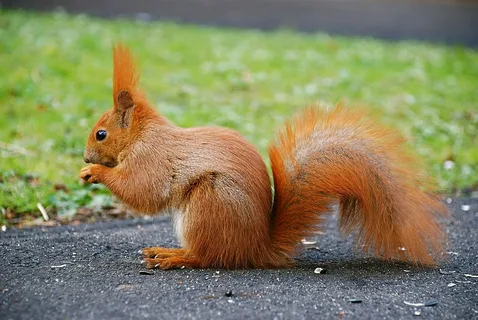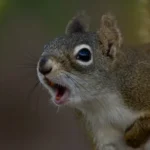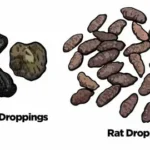Squirrels are common creatures found in urban, suburban, and rural areas across the world.
While their playful antics and bushy tails often delight people, there are aspects of their presence that can be less charming—like their droppings.
Whether you’re an outdoor enthusiast, a homeowner, or simply curious about wildlife, understanding squirrel droppings can provide valuable insights into squirrel behavior, health, and even potential risks.
What Do Squirrel Droppings Look Like?
Squirrel droppings, or feces, are relatively easy to identify once you know what to look for. Here are the key characteristics:
- Shape and Size: Squirrel droppings are typically small, about 1/4 inch to 1/2 inch in diameter, and can vary in length from 1 to 2 inches. They are cylindrical and usually have a smooth surface. The shape is often described as resembling small pellets or elongated beans.
- Color: Fresh squirrel droppings are usually dark brown or black. As they dry out, they can turn a lighter, grayish-brown color. The appearance of the feces can be influenced by the squirrel’s diet, which primarily consists of nuts, seeds, and fruits.
- Texture: Fresh squirrel droppings are soft but firm. They are generally not as dry or brittle as other types of rodent droppings, such as those from rats or mice.
What Squirrel Droppings Can Tell You
Squirrel droppings may seem like a minor detail, but they can tell you a lot about the squirrel and its behavior. Here are a few insights that can be gained from analyzing squirrel feces:
1. Diet:
The content of a squirrel’s diet is often reflected in the droppings. Squirrels are primarily herbivores, feeding on a variety of nuts, seeds, berries, and occasionally tree bark or fungi.
Their droppings will typically show signs of plant matter, with remnants of seeds or nuts visible in the feces.
A noticeable difference in their droppings can also indicate that the squirrel has been consuming a larger amount of a particular food, such as acorns or berries, depending on the season.
2. Health Indicators:
The state of squirrel droppings can also be a sign of the squirrel’s overall health. If the feces are unusually soft, have a foul odor, or contain a lot of mucus, it could indicate that the animal is suffering from illness or parasites.
A sudden change in their droppings, such as the appearance of undigested food or blood, can be a red flag that the squirrel is unwell or injured.
3. Presence of Squirrels:
Finding squirrel droppings in your attic, on your roof, or in your yard is a clear indication that squirrels are nearby.
Squirrel droppings often accumulate near nests or feeding areas, so their presence can point to locations where squirrels are living or frequenting.
Droppings near entry points, such as holes or gaps in the roof, can also reveal where squirrels are entering your home or structure.
Why Are Squirrel Droppings a Concern?
While squirrel droppings may seem like a natural part of outdoor life, they can pose several health risks to humans, especially when squirrels invade your home or attic. These include:
1. Hantavirus:
Squirrel feces can carry the risk of hantavirus, a rare but serious disease that is transmitted by rodents.
While hantavirus is more commonly associated with mice and rats, it is possible to contract the virus through direct contact with squirrel droppings or urine.
Symptoms of hantavirus include fever, muscle aches, and shortness of breath. It’s essential to exercise caution when cleaning up after squirrels.
2. Salmonella:
Like many animals, squirrels can carry bacteria such as Salmonella in their droppings. This bacteria can be harmful if it contaminates food or surfaces.
Salmonella infections can lead to gastrointestinal issues like nausea, vomiting, and diarrhea. Proper sanitation is essential when handling any areas affected by squirrel droppings.
3. Parasites:
Squirrel droppings may harbor parasites like ticks, fleas, or mites. These can transmit various diseases to humans and pets.
For example, fleas on squirrels are known to carry the bacteria that cause bubonic plague, although this is rare.
How to Safely Clean Up Squirrel Droppings
If you find squirrel droppings in or around your home, it’s important to take appropriate steps to clean up safely. Here’s what you should do:
- Wear protective gloves to avoid direct contact with the droppings.
- Use a mask to avoid inhaling any particles that might be present in the droppings or the surrounding area.
- Disinfect the area thoroughly with a cleaning solution or disinfectant. You may also want to use a mixture of bleach and water (1 part bleach to 10 parts water).
- Avoid sweeping or vacuuming droppings, as this can stir up dust and particles that may contain harmful bacteria or viruses. Instead, use a damp cloth or disposable wipes to remove them.
Preventing Squirrel Infestation
If you are regularly encountering squirrel droppings around your home, it may indicate that squirrels are nesting in or around your property. To prevent an infestation:
- Seal entry points: Inspect your roof and attic for gaps or holes where squirrels might enter and seal them off.
- Trim trees and shrubs: Squirrels often use tree branches as a bridge to access homes. Keep branches trimmed and away from the roofline.
- Remove food sources: Avoid leaving bird feeders or exposed food that might attract squirrels. Secure trash cans and compost bins tightly.

Conclusion
Squirrel droppings may seem like a small detail, but they offer a wealth of information about the health, habits, and presence of these curious creatures.
While they can pose health risks if not handled properly, understanding their characteristics and knowing how to deal with them can help you manage squirrel-related issues and maintain a safe, clean environment in and around your home.



